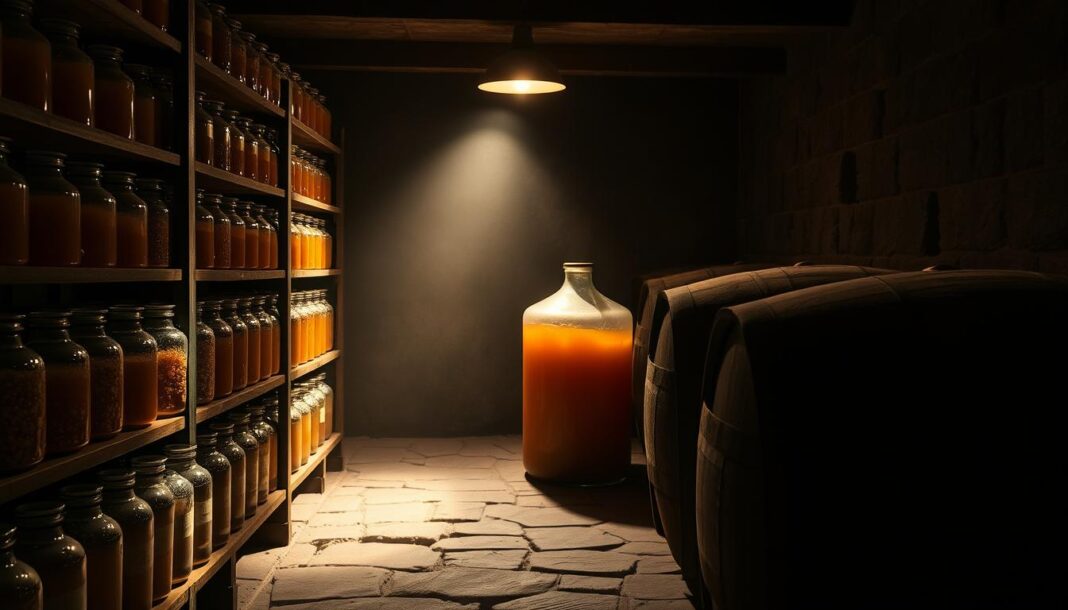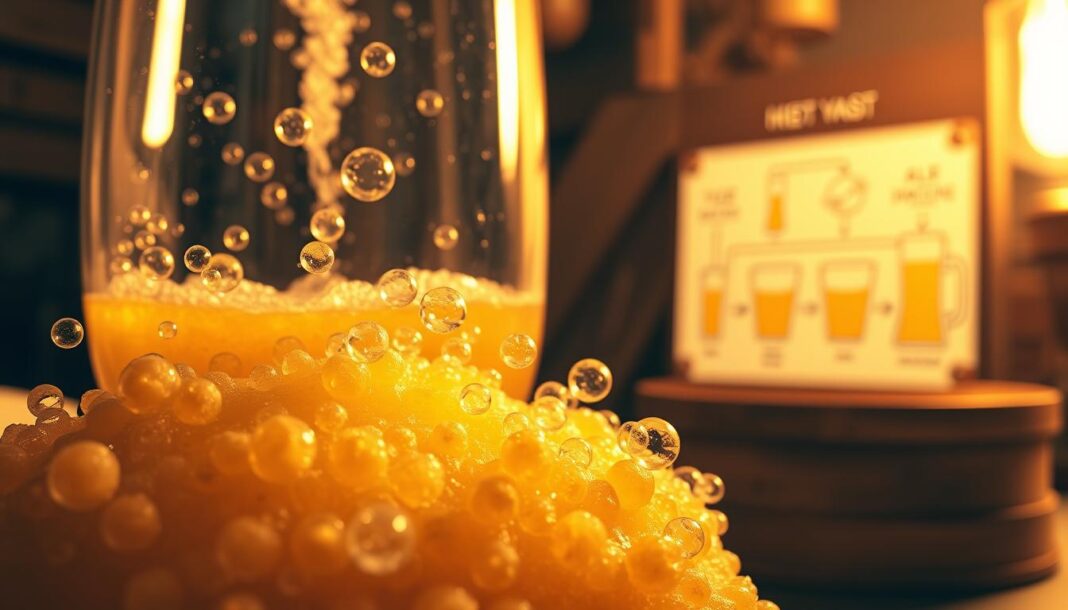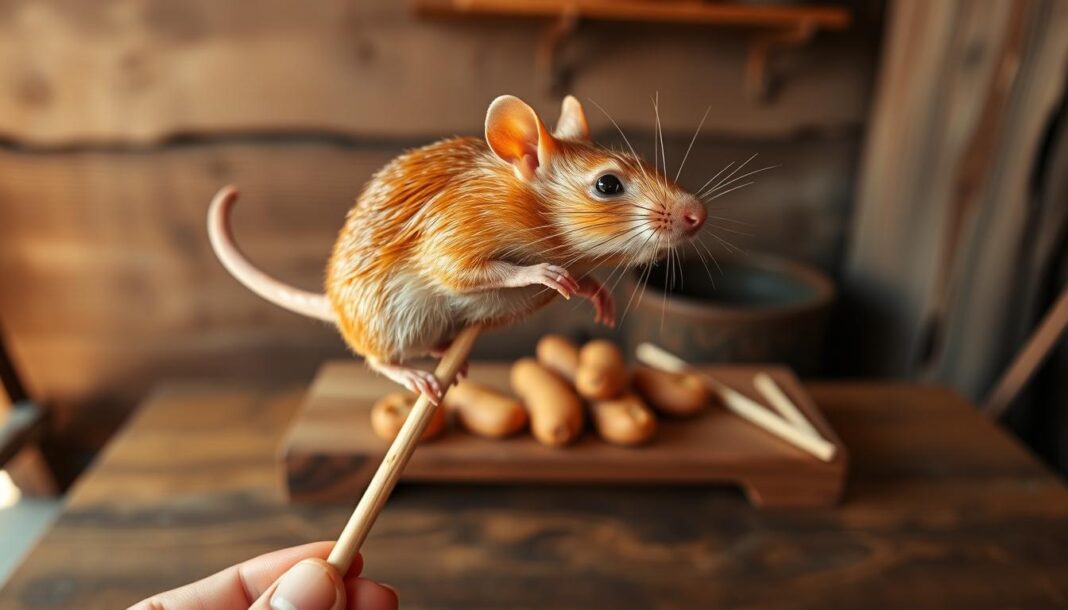As the last fruits of the year ripen in November and December, we seize the opportunity to start one final batch of homemade persimmon wine. This late-season fruit offers a unique sweetness that’s perfect for winemaking. At Historical Foods, we’ve refined our persimmon wine recipe through multiple batches to ensure consistent results, even for those new to home winemaking.
Our comprehensive, tested method for creating a delicious 5-gallon batch of persimmon wine showcases the fruit’s unique flavor profile. With a rich tradition in home fermentation, persimmon wine offers a wonderful balance of sweetness and complexity that’s difficult to find in commercial wines.
Key Takeaways
- Our recipe yields approximately 25 bottles of wine (750ml each) with an alcohol content of 12-14%, depending on sugar content and fermentation conditions.
- The total process takes about 3-4 months from start to finish, with most of that time being passive fermentation and clearing.
- We’ll cover everything from selecting the right persimmons to the final bottling process.
- Special attention is given to the critical fermentation stages to ensure successful persimmon wine production.
- Our method has been refined through multiple batches to ensure consistent results.
The Sweet Potential of Persimmon Wine
The journey to creating exceptional persimmon wine begins with understanding the unique characteristics of persimmons. Persimmons offer a fascinating foundation for winemaking due to their inherent qualities that make them stand out among other fruits.
Why Persimmons Make Excellent Wine
Persimmons are particularly well-suited for winemaking because of their naturally high sugar content, which fuels fermentation without needing excessive added sweeteners. The unique flavor profile of persimmons, combining notes of honey, apricot, and subtle spice, creates a complex wine that’s hard to achieve with more common fruits. Additionally, persimmons contain natural tannins that positively contribute to the wine’s structure and aging potential, especially when using astringent varieties.
The natural pectin in persimmons helps create body in the finished wine, though it necessitates the use of pectic enzyme to prevent cloudiness. We’ve found that balancing the fruit’s natural sweetness with enough acidity is crucial to prevent a cloying finish, a balance we address in our persimmon wine recipe formulation.

Understanding Persimmon Varieties for Winemaking
Although there are many varieties of persimmons, they are primarily categorized into two types: Dan Gam (Fuyu persimmon) and Ddulben Gam (Hachiya persimmon). Fuyu persimmons are sweet, with a squashed-tomato shape, and work best for wine when fully ripe but still firm. Hachiya persimmons, on the other hand, are pointier and larger, requiring complete softness before use due to their high tannin content when unripe.
American persimmons (Diospyros virginiana) can also be used, offering a more intense flavor profile, though they are smaller and require more processing. The choice of persimmon variety significantly impacts the final flavor and quality of the persimmon wine.
Persimmon Wine Recipe 5 Gallon – Complete Ingredients List

Our 5-gallon persimmon wine recipe requires a specific set of ingredients to achieve the perfect balance of flavors. To start, you’ll need to gather several key components that will contribute to the overall quality and character of your wine.
Essential Ingredients and Measurements
The ingredients for our 5-gallon persimmon wine recipe are carefully selected to ensure a balanced and flavorful wine. You’ll need:
- 15 lbs. of persimmons – Providing the optimal fruit-to-water ratio for balanced flavor intensity and proper fermentation.
- 10½ lbs. of granulated sugar – To achieve the target potential alcohol content of 12-14%, though this can be adjusted based on your preference for sweetness and strength.
- 1 tbsp. Yeast Energizer – To support healthy yeast activity during fermentation.
- ¾ tsp. Pectic Enzyme – Essential for breaking down the fruit’s natural pectin, which would otherwise create a permanently cloudy wine.
- 3 tbsp Acid Blend – To balance the fruit’s natural sweetness and create a well-rounded flavor profile.
- ½ tsp. Wine Tannin – For structure and to enhance the overall character of the wine.
- 1 Packet of Wine Yeast: Pasteur Champagne – Recommended for its reliable fermentation properties and ability to highlight fruit flavors.
- 10 Campden Tablets – For sanitization and stabilization, with 5 used prior to fermentation and 5 at bottling time.
Equipment You’ll Need
In addition to the ingredients, you’ll need specific equipment to ensure a smooth winemaking process. This includes:
- A 6-7 gallon primary fermenter (food-grade plastic bucket with lid) for initial fermentation.
- A 5-gallon glass carboy for secondary fermentation.
- An airlock and bung to allow CO2 to escape while keeping air out.
- A long spoon for stirring and a hydrometer for measuring sugar content.
- Siphon tubing and bottles with corks for storing the finished wine.
- Sanitizing solution to ensure all equipment is properly cleaned and sanitized.
Step-by-Step Fermentation Process
Fermentation is the heart of winemaking, and with our step-by-step guide, you’ll be well on your way to creating a delicious 5-gallon batch of persimmon wine. This process involves several critical stages, from preparing your persimmons to monitoring the fermentation progress.
Preparing Your Persimmons
Begin by properly preparing your persimmons: cut them in half, remove all seeds, and slice into small pieces. It’s crucial to avoid over-processing in a blender or food processor, as this can extract bitter compounds from the skins and seeds. Place the prepared persimmon pieces in a nylon straining bag within your primary fermenter.
Primary Fermentation Stage
Mix all the wine making ingredients, except for the yeast, into the primary fermenter. Add water to reach the 5-gallon mark and stir thoroughly to dissolve all components. After adding Campden tablets, wait 24 hours before sprinkling the yeast over the surface of the juice. Maintain a temperature between 70-75°F (21-24°C) for optimal yeast activity, covering the fermenter with a clean towel.
Secondary Fermentation and Clearing
After 5 to 7 days of active primary fermentation, remove the pulp bag, squeezing gently to extract remaining juice, and transfer the liquid to a carboy for secondary fermentation. Attach an airlock to the secondary fermenter to allow carbon dioxide to escape while preventing oxygen and contaminants from entering.
Racking and Monitoring
After 3-4 weeks, rack (siphon) the wine to a clean carboy, leaving sediment behind. Monitor the specific gravity with a hydrometer throughout the process. The fermentation is complete when the specific gravity finishes between 0.990-0.998.
| Stage | Duration | Key Actions |
|---|---|---|
| Primary Fermentation | 5-7 days | Add yeast, maintain temperature, stir daily |
| Secondary Fermentation | 3-4 weeks | Transfer to carboy, attach airlock |
| Racking | After 3-4 weeks and again after 4-6 weeks if necessary | Siphon wine to clean carboy, leaving sediment behind |
By following these steps and closely monitoring your wine‘s progress, you’ll be able to create a high-quality persimmon wine that’s sure to impress. Happy winemaking!
Bottling, Aging and Enjoying Your Persimmon Wine
The journey to perfect persimmon wine doesn’t end at fermentation; it continues with careful bottling and aging. Once your persimmon wine has cleared completely, it’s time to siphon it off the sediment again, leaving as much sediment behind as possible. Before bottling, we recommend ensuring that the fermentation process has fully stopped and the wine has cleared, which typically takes 3-4 months. To prevent re-fermentation, especially if you prefer a sweeter wine, add a wine making stabilizer like Potassium Sorbate and crushed Campden tablets.
For a crystal-clear wine, consider using fining agents such as bentonite or isinglass, following the package instructions for the correct dosage. When bottling, it’s crucial to siphon the wine off the sediment meticulously, being prepared to sacrifice a small amount of wine to maintain clarity and flavor. Use proper wine bottles and new corks, ensuring everything is sanitized before filling. Green or amber bottles are recommended to protect the wine from light exposure.
After bottling, allow your persimmon wine to age for at least 3-6 months. This aging period significantly improves the flavor integration and smoothness. For the best results, store the bottles horizontally in a cool, dark place with a consistent temperature between 55-60°F (13-15°C). When serving, treat persimmon wine like a dessert or semi-sweet white wine, chilling it to about 50-55°F (10-13°C). It pairs well with mild cheeses, nuts, light desserts, or Asian cuisine featuring sweet and savory elements.
Keeping detailed notes on your persimmon wine batch, including measurements, timing, and observations, will help refine future batches and develop your perfect recipe. With patience and practice, you’ll master the art of making exceptional persimmon wine, enjoying the fruits of your labor with family and friends.


